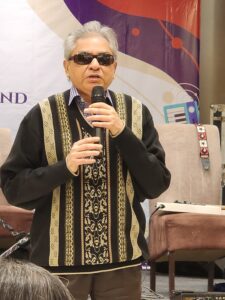Nari (Nariman) Gandhi, often called the Howard Roark of India, continued the legacy of his master Frank Lloyd Wright’s organic architecture; creating self-reliant, natural buildings that looked a part of their surroundings and allowed natural light and ventilation in abundance. He gradually developed his own style that had the fragrance of the local culture and the local milieu. Nari never compromised with his principles or his style, he designed just thirty odd buildings during his illustrious career that was cut short when he met with a tragic car accident at the age of fifty nine.
His site was his office
Nari Gandhi never followed the established form of architecture, he didn’t believe in producing paper drawings like floor plans, elevations or sections etc. He didn’t work from an office, spending time on his sites to work closely with masons. He used a cane to draw his plans on the ground and often worked with his own hands; Ayn Rand’s Howard Roark at work! Pure geometry decided the form of his buildings as is clearly demonstrated by the work we are discussing today in this post.

Nari Gandhi’s first project: The Gobhai mountain lodge at Lonavla
Nari apprenticed under the great Frank Lloyd Wright for five years. After Wright’s death in 1959, he did a two-year course in pottery before returning to India in early 1960’s. His first project was in Lonavla near Mumbai for one of his friends. The lodge is located on an inaccessible cliff top; it’s a very remote location near an elevated dam reservoir. It’s difficult to access even with a heavy vehicle.
Springing out of its surroundings
Even the very first project completed by this maverick architect has the stamp of his personality. He had a firm belief in the principles of organic architecture, he believed that a building should be a part of its surroundings. Gobhai Mountain Lodge is no different. Its design responds to the specific conditions of the site. It allows maximum sunlight into the interior spaces while blocking the torrential rains prevalent in the region. The architect didn’t go for any expensive, manufactured materials but used the locally available natural material like quarried stone.
Dynamic geometry
The form of Nari’s buildings was always determined by the geometry of his sites. Here too he develops his geometry from the nature of two main distant views- the Rajmachi hilltop fort and the Valvan Lake below. The verandahs of the lodge overlook the fort and the lake, a constant source of joy for the inhabitants.
The lodge building has a wonderfully dynamic triangular form; the roof beams are set at 30 degrees while the roof panels are placed perpendicular to the walls. These two geometries emerge from the nature of the main views around, as mentioned earlier. The large triangular roof has deep overhangs over verandahs, including long projections at the gable ends, and eaves touching the ground. It’s made of sheets of asbestos cement. The roof trusses are wooden; the flooring is plain concrete which adds dynamism to the structure with grooves following the triangular geometry of the roof.
First use of Wright’s Taliesin West desert masonry method in India
For the lodge building Nari made use of Taliesin West desert masonry method often employed by Frank Lloyd Wright for his projects. He used the locally quarried stones for the walls of the house; the large stone blocks were placed within a wooden framework, flat-finished sides being on the exterior face. Concrete was poured from the top, wooden framework was removed after concrete was set. This gave a rough rubble outer finish to the building.
Nari Gandhi was an iconic architect, his buildings being a rare combination of art and architecture. Very few of his structures are standing today but the ones left show his legacy of organic architecture. We shall take a few more of his great works in our future posts.
Sources
archnet.org/sites/6335
pc.blogspot.com/2007/12/gobhai-mountain-lodge-nari-gandhi.html
https://www.archnet.org/sites/6335
ABOUT THE AUTHOR

Sandeep Singh is an architect from IIT Roorkee.
Ten years after graduating, he lost his vision to genetic Diabetes.
He reinvented his career and turned writer.
He has authored two fiction books and writes blogs on
Architecture, Outsourcing, Safety and a variety of other
subjects for different organizations. He also chairs and runs two NGOs

